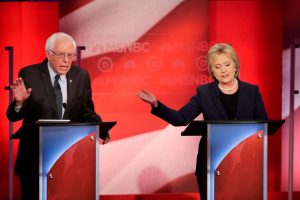APRIL 12, 2019
 Sen. Bernie Sanders, I-Vt, and former Secretary of State Hillary Clinton spar in February 2016 during a Democratic presidential primary debate hosted by MSNBC at the University of New Hampshire in Durham, N.H. – David Goldman/AP
Sen. Bernie Sanders, I-Vt, and former Secretary of State Hillary Clinton spar in February 2016 during a Democratic presidential primary debate hosted by MSNBC at the University of New Hampshire in Durham, N.H. – David Goldman/AP
After Bernie Sanders lost his primary campaign for president against Hillary Clinton in 2016, a Twitter account called Red Louisiana News reached out to his supporters to help sway the general election. “Conscious Bernie Sanders supporters already moving towards the best candidate Trump! #Feel the Bern #Vote Trump 2016,” the account tweeted.
The tweet was not actually from Louisiana, according to an analysis by Clemson University researchers. Instead, it was one of thousands of accounts identified as based in Russia, part of a cloaked effort to persuade supporters of the Vermont senator to elect Trump. “Bernie Sanders says his message resonates with Republicans,” said another Russian tweet.
While much attention has focused on the question of whether the Trump campaign encouraged or conspired with Russia, the effort to target Sanders supporters has been a lesser-noted part of the story. Special counsel Robert S. Mueller III, in a case filed last year against 13 Russians accused of interfering in the U.S. presidential campaign, said workers at a St. Petersburg facility called the Internet Research Agency were instructed to write social media posts in opposition to Clinton but “to support Bernie Sanders and then-candidate Donald Trump.”
That strategy could receive new attention with the release of Mueller’s report, expected within days.
Sanders told Vermont Public Radio last year that one of his campaign workers figured out what was going on, alerted the Clinton campaign and told them, “I think these guys are Russians.” But Sanders said he never knew, and he later backed off his suggestion that his staff did. A spokesman referred questions to 2016 campaign manager Jeff Weaver, who said in an interview that Sanders “misspoke a little bit and conflated a few of the facts. … He did not know, I did not know, none of us knew” that Russia was behind the efforts.
Only recently, with the latest analysis of Twitter data, has the extent of the Russian disinformation campaign been documented on that social media platform.
A pair of Clemson University researchers, at the request of The Washington Post, examined English-language tweets identified as coming from Russia, many of which were designed to influence the election. It is impossible to say how many were targeted at Sanders supporters because many don’t include his name. Some 9,000 of the Russian tweets used the word “Bernie,” which were “liked” 59,281 times and retweeted 61,804 times.
But that was only one element of the Russian effort to target Sanders supporters, the researchers said. Many thousands of other tweets, with no direct reference to Sanders, were also designed to appeal to his backers, urging them to do anything but vote for Clinton in the general election.
“I think there is no question that Sanders was central to their strategy. He was clearly used as a mechanism to decrease voter turnout for Hillary Clinton,” said one of the Clemson researchers, Darren Linvill, associate professor of communications. The tweets examined in the new analysis “give us a much clearer understanding of the tactics they were using. It was certainly a higher volume than people thought.”
The Russian social-media strategy underscores a challenge that Sanders faces as he once again seeks the Democratic presidential nomination, this time in a crowded field. Many Sanders supporters believe he was treated unfairly by the Democratic Party and Clinton, a point the Russians sought to capitalize on as they worked to undermine Clinton in the November election.
Although Sanders later denounced the Kremlin’s efforts and campaigned for Clinton, some Democrats believe he could have done more to smooth over tensions and encourage his supporters to support his onetime opponent. A former senior Clinton campaign official, speaking on the condition of anonymity to avoid publicly criticizing Sanders ahead of the 2020 primaries, said there remains bitterness over the way Sanders repeatedly said the system was tilted against him.
Sanders said in May 2016 that party rules enabling Clinton to collect “superdelegates” did not meet the definition of “rigged,” but he called it a “dumb process which certainly has disadvantaged our campaign.”
The effort to promote Sanders as a way to influence the U.S. election began shortly after he declared his candidacy in spring 2015, according to Mueller’s indictment of the Russians. Russia’s aim was to defeat or weaken Clinton, who had angered Russian President Vladimir Putin when she had been secretary of state.
One reason that Sanders was on Russia’s radar has been little noted: he, like Trump, opposed trade deals such as the Trans-Pacific Partnership. Putin had been critical of the TPP, saying it was secretive and “hardly facilitates sustainable development of Asia Pacific.”
During the primaries, Sanders gave at least three interviews to a Russia-controlled television network, RT, in which his trade stance was highlighted. The network in February 2016 criticized MSNBC for breaking away from Sanders after he said he was “helping to lead the opposition to the Trans-Pacific Partnership.” The network posted a story headlined, “Bernie Sanders ‘censored’ by MSNBC while criticizing trade deal.”
Around the same time that Sanders was featured on RT, Russian employees at the Internet Research Agency were given a document explaining how to influence the U.S. election. The workers were told to “use any opportunity to criticize Hillary and the rest (except Sanders and Trump — we support them),” according to Mueller’s indictment of the Russians.
The Twitter database shows the impact. The tweets sent from Russia, cloaked to look as though they came from Americans, included: “Bernie Sanders looks to black voters to boost his underdog campaign”; “Hillary Clinton’s summer of drama creates openings for Bernie Sanders and Joe Biden”; and “I’m for Bernie all the way!”
Then, in July 2016, WikiLeaks released emails from the Democratic National Committee that suggested the party machinery was tilted against Sanders. The DNC computers were later revealed to have been hacked by Russia. The hack prompted Trump to stoke the divide among Democrats. “Leaked e-mails of DNC show plans to destroy Bernie Sanders,” Trump tweeted July 23, 2016. “. . . On-line from Wikileakes [sic], really vicious. RIGGED!”
Russian trolls significantly increased their effort to persuade Sanders supporters to oppose Clinton in the general election. One of their methods was to try to convince African Americans that they couldn’t trust her.
“#BlackMenForBernie Leader Switches to Trump! I will Never Vote for Hillary,Welcome aboard the Trump Train,” said a tweet from an account that was said to come from Texas and was identified as “Southern. Conservative Pro God. Anti Racism.” The account, actually operated by a Russian, had 72,121 followers. The message was liked 260 times and retweeted 295 times, according to the Clemson database.
Linvill, the Clemson researcher, said Sanders was seen as “just a tool” to the Russians. “He is a wedge to drive into the Democratic Party,” resulting in lower turnout for Clinton, he said. The tweets suggested either voting for Trump or a third-party candidate such as Green Party nominee Jill Stein, or writing in Sanders’s name.
While it is impossible to show a direct correlation between a Russian-based tweet and someone’s vote in the United States, a post-election survey conducted for Ohio State University documented how false stories spread on social media may have caused a decline in turnout for Clinton. Only 77 percent of those surveyed who had voted for Barack Obama in 2012 supported Clinton in 2016; 10 percent backed Trump, 4 percent voted for third-party candidates, and 8 percent did not vote, according to the YouGov survey.
In an effort to demonstrate how inaccurate information makes its way into the mainstream, the survey asked respondents about three demonstrably false articles that had been widely distributed. A quarter of respondents believed the false story that Clinton was in “very poor health,” 10 percent believed that Trump had been endorsed by the Pope, and 35 percent (including 20 percent of Obama supporters) believed that Clinton had approved weapons sales to “Islamic jihadists, including ISIS.”
The Ohio State team concluded in a soon-to-be published final version of its report that “belief in these fake news stories is very strongly linked to defection from the Democratic ticket by 2012 Obama voters.” Obama voters who recognized all three stories as false voted for Clinton at a rate of 89 percent, while 61 percent who believed one of the stories was false voted for her, and 17 percent of those who believed two of the false stories supported Clinton.
Yoel Roth, Twitter’s head of site integrity, said Twitter had studied what happened during the presidential election and will apply those lessons as the 2020 campaign unfolds.
“Protecting the integrity of public conversation around elections is core to Twitter’s mission,” Roth said in a statement to The Post. “Since 2016, we’ve launched new policies, significantly scaled our enforcement against malicious automation, built strong partnerships within the industry and with government entities, and opened the largest public archive of potential information operations online, including thousands of Russian-linked accounts we have removed.”
Sanders told Vermont Public Radio last year that the Russians “were playing a really disgusting role because they don’t believe in anything. And all they want to do is sow division in this country, bring people against each other. So what they were saying is — in so many words — is Bernie Sanders is not going to win, so if you are a Bernie Sanders supporter, let me tell you, Hillary Clinton is a criminal, a murderer, a terrible person . . . crazy, all of these disgusting things.”
Clinton spokesman Nick Merrill said “the Russians will strike again.” As a result, he said, it is imperative for “everyone else, especially Democratic candidates, to work together and support each other to defend against these threats.”
Courtesy/Source: Washington Post










































































































